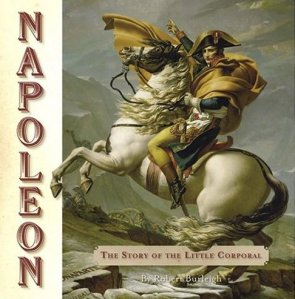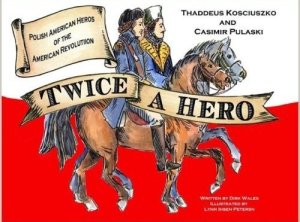 There are very few children’s books on Napoleon. There are hundreds of thousands of books for adults but only a handful of children’s books – only three in print that I could find. Napoleon is an important historical figure, perhaps one of the two or three greatest generals in all of recorded history, in the rarefied company of Alexander the Great and Julius Caesar. Like Alexander and Julius Caesar, although we admire their genius, there are lingering questions about their personal character and the distorting effects of their own egos and ambitions.
There are very few children’s books on Napoleon. There are hundreds of thousands of books for adults but only a handful of children’s books – only three in print that I could find. Napoleon is an important historical figure, perhaps one of the two or three greatest generals in all of recorded history, in the rarefied company of Alexander the Great and Julius Caesar. Like Alexander and Julius Caesar, although we admire their genius, there are lingering questions about their personal character and the distorting effects of their own egos and ambitions.
Napoleon, in addition to his military genius, is in many ways the father of modern France. Its system of government and laws was created by Napoleon, and has been only slightly modified since. The French still feel an affection and admiration for the “little corporal,” that, while not always shared by the rest of the world, must be grudgingly acknowledged.
Napoleon: The Story of the Little Corporal is a excellent introduction to Napoleon, perfect for middle school students as a first read, useful for high school students and adults who want to start a study of him. It is also a visually fascinating book, since it uses the contemporary (and quite famous) paintings of David, Goya, Gros, Couder and others to illustrate the historical narrative. The artwork is beautiful — the book would be worth buying for the paintings alone!
The book also makes excellent use of the writings of Napoleon himself. Indeed, the author’s note states, “I have drawn on Napoleon’s own words to anchor each section, hoping this will give readers a sense of his complex personality. He was a man of action — of that there is no doubt. but he was also a man of words — witty, insightful, and ready to comment on anything and everything — his own life most of all!”
“You tell me it is impossible. There is no such word in French.”
Napoleon became a general before he turned twenty-five and was a famous, victorious field commander before he was thirty. He became First Consul of France without having any political experience, at the age of 30, and Emperor of France at 35. Deposed and exiled to an island in the Mediterranean at age 45, he escaped, returned to France, and was restored to power. A year later, he was forced out again. He spent the last six years of his life a prisoner on an even more remote island in the south Atlantic, dying in 1821 at the age of 52.
“I love power as a musician loves his violin.”
“I am the state — I alone am here the representative of the people.”
“I am an upstart soldier.”
“There is no immortality but the memory that is left in the minds of men.”
A vote was held in France in 1800 to approve the Triumvirate, and Napoleon’s position as First Consul. The results were three million in favor, and 1,500 opposed.
Aside from the fascinating artwork, the author has done an excellent job of telling the story of Napoleon’s brilliant career in a simple straightforward fashion.
Napoleon was the most famous figure in the world for two decades. His example was invoked in the political debates of England, the USA, Italy, Germany, and beyond. His career is still hotly debated. To cite but one example: in the presidential campaign of 1800, Jefferson charged that Adams and Hamilton were planning to the use the army to seize power, following the example of Napoleon.
For all those who are interested in the events of the French Revolution and the Napoleonic wars, this is an essential book.
Napoleon: The Story of the Little Corporal by Robert Burleigh is 48 pages, hardback, $18.95. It can be purchased directly from Greenleaf Press.
 Twice a Hero: Thaddeus Kosciuszko and Casimir Pulaski
Twice a Hero: Thaddeus Kosciuszko and Casimir Pulaski
Polish American Heroes of the American Revolution
There’s a Pulaski County in several states. There’s a city named Pulaski in Tennessee. Pulaski was a Polish patriot who escaped the partition of his own country in Europe and came across the ocean with letters of introduction from Benjamin Franklin. He wrote home to his friends, “If I cannot fight for freedom in my homeland, I will fight for freedom in America.” Pulaski was commissioned a general by the Continental Congress on the recommendation of Franklin and Washington and fought with Washington at Brandywine and later commanded an expedition sent south to retake the port of Savannah. Pulaski was wounded in the battle and died shortly afterwards. His story his told more fully in a ten minute DVD movie included in a flap on the inside cover of the book.
The text of the book focuses on Kosciuszko who came to America without letters of introduction from Franklin. He served as an engineer in the Continental Army and was instrumental in the colonists’ victory at Saratoga and achieved the rank of Colonel. It was the victory at Saratoga that persuaded the French to send troops with Lafayette to assist the colonists. Later, he successfully fortified the Hudson River at West Point so effectively that the British had to abandon plans to sail north and attack Albany. Kosciuszko continued his service with Washington and was present at Yorktown during the siege and surrender, playing a valuable role in laying out the American siege lines.
After the War for Independence, Kosciuszko returned to Poland where he is honored as a leader in the Polish fight for independence from Russia and Germany.
This is a remarkable book, on two figures who ought not to be overlooked. Their stories help all of us to understand that the American Revolution did not happen in a vacuum, but had an impact on contemporaries around the world.
The text is upper elementary, and the book includes a 10 minute public-television-style movie on Casimir Pulaski hosted by the author.
Twice a Hero is 32 pages, hardcover, $18.95 and may be purchased directly from Greenleaf Press.
– Rob Shearer
Director, Schaeffer Study Center
Publisher, Greenleaf Press